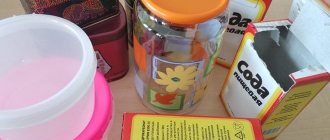Semolina is a wheat product with a grain diameter ranging from 0.25 to 0.75 mm . It boils well and is easily absorbed by the body . Semolina is digested in the lower intestine, so it is useful for diseases of the gastrointestinal tract. Cereals serve as a source of useful minerals: magnesium, calcium, potassium, zinc, iron, phosphorus, etc.
Semolina is considered a product with a long shelf life . In order for the product to retain its quality for as long as possible, it should be provided with the conditions regulated by GOST. Otherwise, the cereal loses its friability and deteriorates due to pests or moldy fungi that have settled in it. The cooked dish becomes bitter. In extreme cases, a spoiled product can be restored, but it is better to initially store the cereal correctly at home.
What color should semolina be?
All grains in the package must be the same in size and shade. If it is “M” brand cereal, then it should be opaque, mealy, white or creamy. Semolina made from durum wheat “T” has a more saturated color - cream or yellowish, but at the same time it is translucent and has a somewhat ribbed shape.
Interesting materials:
In what year did the science of valueology appear? In what year did the first nuclear submarine appear? In what year did the first Bible appear? In what year did the first bottle appear? In what year did the first electric light bulb appear? In what year did the first light bulb appear in Russia? In what year did the first mobile phone appear? In what year did the song Victory Day appear? In what year did the cocoa cocoa song appear? In what year did the Orthodox faith appear?
How long to store
How long semolina can be stored depends on the conditions in which it is located. If it is at a temperature of -5°C -+5°C, its shelf life will be 8 months. And when the storage temperature of semolina is increased to +21°C - only up to 3-4 months.
When there is a need to extend the shelf life of semolina to 1 year or more, you need to protect it from insect attack. To do this, the cereal is kept in the oven (+150°C), stirring constantly for 7 - 10 minutes.
Another good way to get rid of insects is to place the cereal (you will need a suitable container) in the freezer for 24 hours. The semolina should be spent the next 24 hours without a refrigerator, in a place with a low level of humidity, after which it can be considered ready for long-term storage.
What to do with an expired product?
If the nutritional properties are preserved after the shelf life has expired, it is better not to cook porridge from semolina for children, but to use it for adding to baked goods - together with flour. But if rancidity has already appeared, it cannot even be used as a breading. Fungal spores in old semolina, once in the human body, cause intoxication, digestive disorders and other unpleasant symptoms.
If you hate to throw away the product, you can use it in the garden. Cereals will help get rid of ants. To do this, sprinkle semolina around the anthill and the path. Insects eat dry grains, and then they swell in the stomach and the pests die. To increase the effectiveness of the bait, mix:
- with sugar - 3:1;
- with jam - 12:1, and then laid out on a horizontal surface to dry and crushed into powder;
- with soda and powdered sugar - 1:1:4.
Those who do not have a summer house will have to dispose of the product, even if a large amount has spoiled. But there is no need to regret it - health is more valuable.
Interesting! Semolina is coarsely ground wheat. The letters on the packaging indicate quality. “M” means that soft grains were used for grinding - it is more suitable for baking. "T" indicates durum wheat. It contains fewer calories and is more suitable for cooking.
Useful tips
- During storage, the air humidity in the room should not exceed 65-70%, and the temperature should not exceed 19-20 degrees.
- For semolina, pearl barley, millet and oatmeal, cool storage is desirable. Otherwise, they may acquire a bitter taste. This is due to the fact that at temperatures above 16-18 degrees, vegetable fat can go rancid. If you cannot maintain this temperature, buy these cereals in small quantities.
- It is unacceptable to store cereals in basements, poorly ventilated and damp areas.
- Do not scoop sugar, flour or spices with a wet or damp spoon. A wet product can not only lose its quality, but also become moldy. For the same reason, you should not hold open containers with bulk products over a saucepan or frying pan when something is being cooked there.
- Do not store salt, sugar, flour, rice and other cereals in open packages next to foods that have a strong odor. Such products include spices, dried mushrooms and herbs.
- Also, cleaning agents and detergents containing odorous fragrances should not be placed near the storage area for bulk products.
- To preserve the taste of products and protect them from spoilage, try not to make bulk purchases unless absolutely necessary. It's better to renew your supplies as you use them.
We recommend: Is it possible to store butter and vegetable oil in the freezer - what will happen to it
Factors affecting the shelf life of semolina
Semolina can retain its original nutritional properties for a long time, but only if the following factors are taken into account:
- Storage standards regulated by GOST 26791-89. According to sanitary rules, the product should be stored in a dry, dark, well-ventilated place that is not infested with pests. The air temperature should be from +5 to +20°C, the humidity level should be 60-70%.
- Shelf life , which is counted from the date of production. This indicator depends on the manufacturing region. If semolina is produced in factories in the Far East, Lower Volga region, North Caucasus, Transcaucasia, Baltic states, southern Kazakhstan, Ukraine, Central Asia, then the shelf life is 7 months. For other areas - 10 months.
- Storage container . The product should be poured from the original packaging into a glass, ceramic or plastic jar, the lid of which is screwed on tightly. You can also keep cereal in canvas bags.
Preface
The goals, basic principles and general rules for carrying out work on interstate standardization are established by GOST 1.0 “Interstate standardization system. Basic provisions" and GOST 1.2 "Interstate standardization system. Interstate standards, rules and recommendations for interstate standardization. Rules for development, acceptance, updating and cancellation"
Standard information
- 1 DEVELOPED by the All-Russian Research Institute of Grain and Its Processing Products - a branch of the Federal State Budgetary Institution "FSC Food Systems named after. V.M. Gorbatov" RAS (VNIIZ - branch of the Federal State Budgetary Institution "FSC Food Systems named after V.M. Gorbatov" RAS)
- 2 INTRODUCED by the Federal Agency for Technical Regulation and Metrology
- 3 ADOPTED by the Interstate Council for Standardization, Metrology and Certification (minutes of September 30, 2022 Ne 122-P)
The following voted for adoption:
| Short name of the country no MK (ISO 3166) 004-97 | Country code no MK (ISO 3166) 004—97 | Abbreviated name of the national standardization body |
| Belarus | BY | State Standard of the Republic of Belarus |
| Kyrgyzstan | KG | Kyrgyzstandard |
| Russia | RU | Rosstandart |
| Uzbekistan | UZ | Westandard |
| Ukraine | U.A. | Ministry of Economic Development of Ukraine |
- 4 By Order of the Federal Agency for Technical Regulation and Metrology dated October 15, 2022 No. 996-st, the interstate standard GOST 7022-2019 was put into effect as a national standard of the Russian Federation on November 1, 2022.
- 5 INSTEAD GOST 7022-97
Information on the entry into force (termination) of this standard and amendments to it on the territory of the above states is published in the indexes of national standards published in these states, as well as on the Internet on the websites of the relevant national standardization bodies.
In case of revision, modification or cancellation of this standard, the relevant information will be published on the official website of the Interstate Council for Standardization, Metrology and Certification in the catalog “Interstate Standards”
Standardinform. decor. 2019
In the Russian Federation, this standard cannot be fully or partially reproduced, replicated and distributed as an official publication without permission from the Federal Agency for Technical Regulation and Metrology
What happens to semolina over time?
If stored incorrectly, food will spoil. Signs by which you can understand that it’s time to throw away semolina:
- There was a musty smell. Normally it shouldn't be there. Those who are particularly sensitive can detect the sweetish aroma of ground wheat, but no more.
- If lumps appear when shaking, the cereal has become damp.
- The taste has changed - bitterness has appeared. Rarely does anyone taste a raw product; an unpleasant shade is revealed in the finished dish. To prevent this from happening, it is advisable to chew a few grains before cooking or baking.
- Dark spots indicate that there are bugs. And wet lumps are used to colonize the container with food moths.
Over time, the composition of the cereal changes. But despite the fact that dry and clean expired semolina contains much less vitamins and minerals than fresh semolina, it can be eaten. But before you cook the porridge, you should carefully examine and smell it, evaluate its taste properties not only in its raw form, but also in its swollen form. Periodically - at least once a month - you need to pour a small amount of boiling water or milk. If no bitterness appears, you can continue storing it.
How to choose a container?
How long semolina is stored depends on the choice of container. If the lid fits tightly, it can remain in place for 6-9 months. If the product was packaged in paper packaging, there is no need to pour it in until it is opened. You will have to immediately transfer the semolina into a plastic bag.
The basic requirements for new containers are that all containers must be clean and dry. You should not choose “convenient” jars with sliding spouts or holes in the lid - they allow moisture to pass through.
Packages and bags
Experienced housewives advise storing semolina in cotton bags with drawstrings. To prevent bugs from infesting them, the fabric is first boiled in a high concentration saline solution. Then dry thoroughly - preferably in the sun. The fabric prevents the semolina from drying out, providing good ventilation. Salt suppresses the activity of mold fungi, from which cereals suffer the most.
If there is a small amount of cereal or it is used quickly, then it does not need to be poured. There will be no problems if you leave it in a paper bag.
Marking
Each package of goods indicates:
- manufacturer, details;
- Product name;
- its mass;
- date of manufacture;
- shelf life;
- details of the standard or specifications;
- the nutritional value.
When packaging by an enterprise, markings are applied typographically to the packaging. When a supermarket sells goods by weight, the data is placed inside or glued to the top of the container.
Dear readers! To solve your problem right now, get a free consultation
— contact the lawyer on duty in the online chat on the right or call: +7 (499) 938 6124 — Moscow and region. +7 (812) 425 6761 — St. Petersburg and region. 8 (800) 350 8362 - Other regions of the Russian Federation You will not need to waste your time and nerves
— an experienced lawyer will take care of all your problems!











